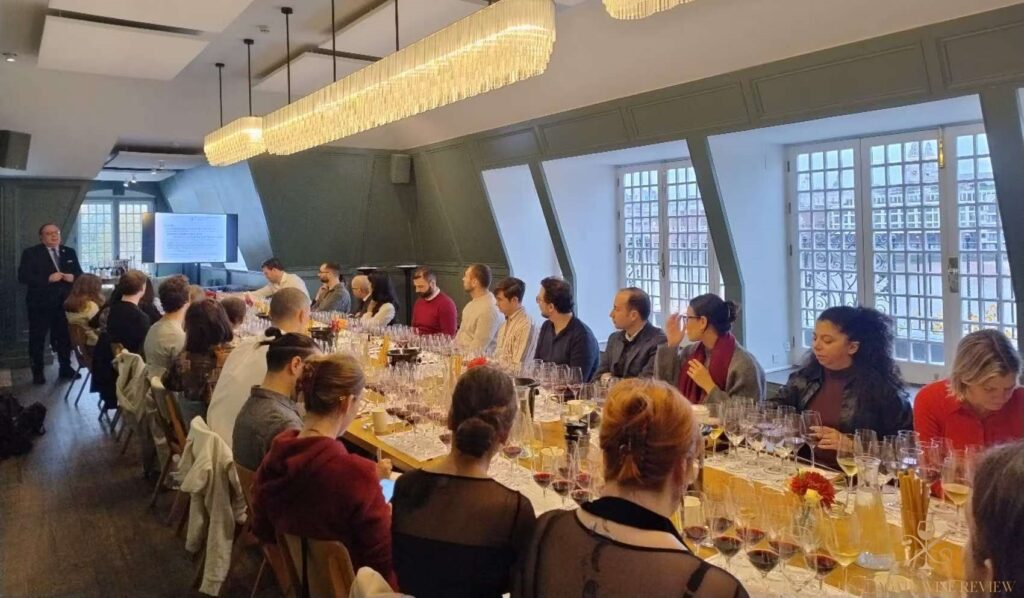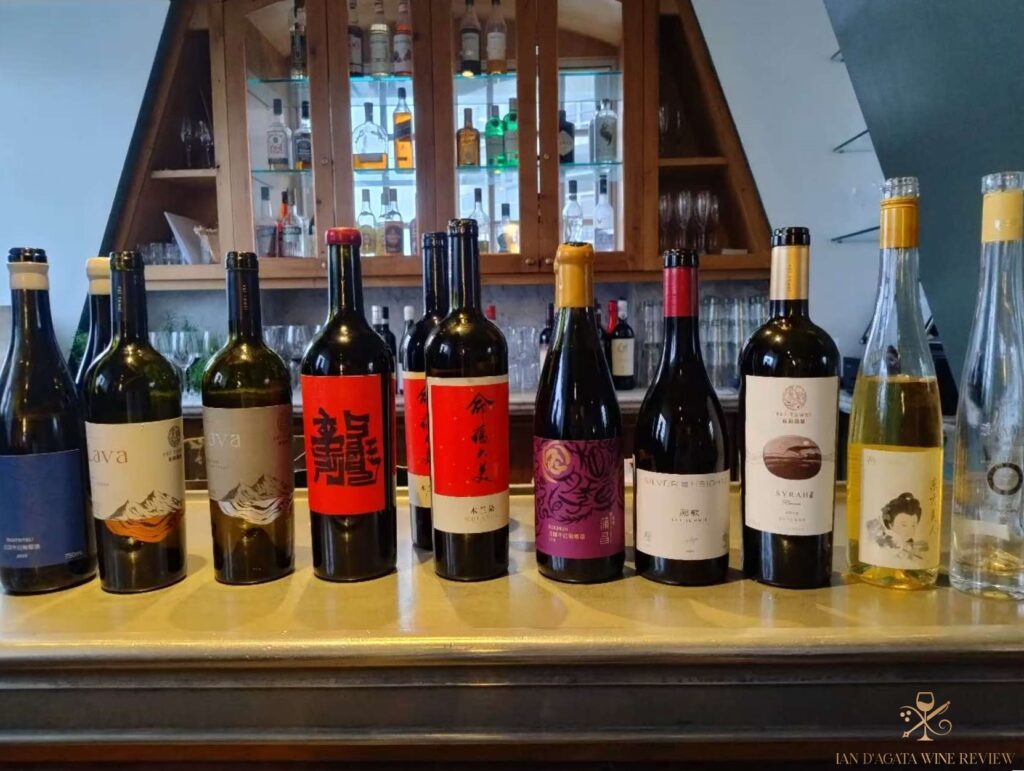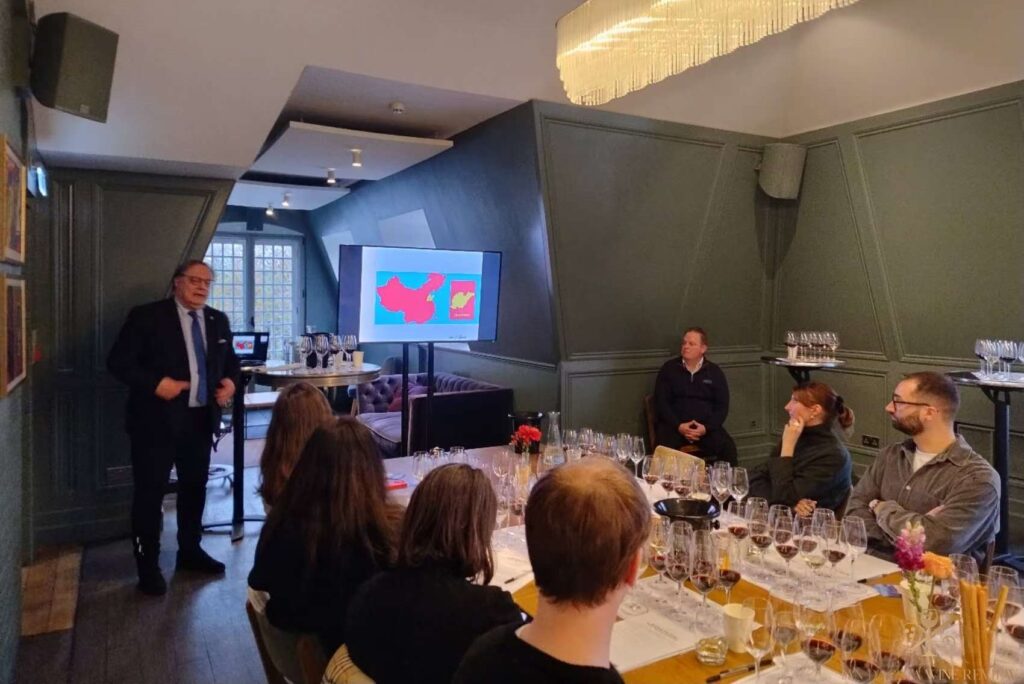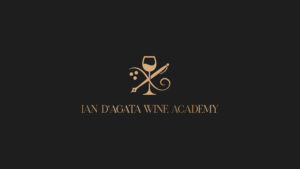On Monday November 10, London’s prestigious The Swan/The Globe venue, where Shakespeare’s plays were first shown to a general public centuries ago, was the site of a day of masterclasses, lasting from ten in the morning to three in the afternoon devoted to Italian and Chinese wines.

The event was by invitation-only, and reserved for wine professionals, almost exclusively devoted to the city’s most important sommliers (wine bistros or Michelin-starred). In fact, the event proved so popular that besides filling up immediately with long waiting lists, a number of somms actually flew in or took the train to attend, such as in the case of one head somm from an out of town three Michelin star restaurant.

The day featured three masterclasses: Native to international, famous to unknown: Italy’s great native grapes and wines with Ian D’Agata; Lorenza Sebasti and Cristiana Tiberio: two absolute Italian wine stars and their wines from Castello di Ama and Tiberio; and A unique experience: getting to know China’s best wines region by region with Ian D’Agata.

The first masterclass, Native to international, famous to unknown: Italy’s great native grapes and wines with Ian D’Agata featured Ian’s usual savvy mix of extremely well-known iconic bottlings from great vintages (unlike at many other wine events where organizers try to impress with famous labels but what are actually bad years) to extremely rare, essentially unheard of grape varieties and wines. Things started off marvelously with the Cave de Morgex et La Salle 2019 Roussì Metodo Classico Vino Spumante, a traditional method bubbly that spent 60 months on the lees and is made with Italy’s rarest grape. In fact, the wine doesn’t even exist yet, and the somms in attendance in London can say they were the first to ever taste this wine. Made in only 150 bottles to go on sale next year directly at the shop of the cave in beautiful Valle d’Aosta, the grape variety formerly known as Roussin de Morgex and now called (for EU bureaucratic reasons) Roussì. Its is high-acid, delicate rosé bubbly that reminds of rosehips, redcurrants and white flowers.Nobody in attendance had ever heard of the grape and consequently never tasted a wine made with it, so this proved to be a great debut to the one-and-a-half hour session. Following a rarer than rare wine, a bunch of very well-known ones: two more bubblies followed by Gemin, Prosecco Superiore (or Prosecco DOCG) bottlings that showcased well the goodness that’s typical of the wines made in the limited, small, Conegliano-Valdobbiadene denomination. Piccini is abig producer that long made decent but not memorable wines, but things have begun to turn in the right direction with the arrival on board of Antonio Ciccarelli, the new & Communication manager who spent years at Marc de Grazia’s Florence office establishing its Italian wineries in the USA and all over the world. The Etna wines of Torre Mora and the Chianti Classicos of the Fattoria di Valiano were true-to-type and well-made. There can be no doubt of the huge improvement that has taken place at Piccini in just a few years. Terenzuola is an estate that falls back into the little-known category, and very few in attendance or anywhere else for that matter had ever tried a Vermentino Nero wine or one made with 100% Canaiolo Nero. The two wines were not just delicious but the proof of what good can come out of resurrecting local native grapes that had previously been forgotten. That Ivan Giuliani, owner of Terenzuola did so by working with Prof. Giancarlo Scalabrelli, one of Italy’s greatest grape luminaries, and studied over 200 varieties before settling on the right ones for his terroir, tells you all you need to know about the man and that success does not come only by wishful thinking. The masterclass finished off with the wines of the iconic Tua Rita estate, one of which is among the twenty-five or so greatest wines Italy has made in the last thirty years. Tua Rita’s 2021 Merlot Redigaffi Toscana is magical work of art, a world-class Merlot wine like only the Bordeaux right bank can produce with tannins so silky they are literally enchanting. The mostly Cabernet Sauvignon-based 2021 Giusto di Notri is not far behind it in quality. All in all, a great showing for Italian wines that left the audience suitably impressed.

Lorenza Sebasti and Cristiana Tiberio: two absolute italian wine stars and their wines from Castello di Ama and Tiberio
Two of the world’s leading wineries, Castello di Ama in Tuscany and Tiberio in Abruzzo have been continuously breaking new ground since their establishment. Led by two talented, insightful and highly cultured women who have a thinking-out-of-the-box capacity to go where few in Italy had, and have, ever gone before, Lorenza Sebasti of Ama and Cristiana Tiberio of Tiberio have produced numerous iconic wines over the years that are much sought after by starred restaurants and wine collectors internationally.
Lorenza Sebasti was the first, already in the 1980s, to recognize and actively shine the spotlight on Chianti Classico’s similarities to Burgundy rather than Bordeaux, then the prevailing current of thought. Therefore, she chose to highlight single-vineyard wines at a time when “entry-level” and “Riserva” where the common coin. Furthermore, she refused the notion that the wines of Chianti Classico should be viewed as just “cheap and cheerful” quaff, and fought hard for worldwide recognition and acceptance of the real value and hence more realistic pricing for Chianti Classico’s best wines. Last but not least, with her Apparita wine, she and her team created one of the world’s greatest 100% Merlot wines, an iconic red that offers a different but just as interesting expression of the grape compared to that of Bordeaux’s right bank, for example.
At Tiberio, Cristiana Tiberio has done immensely important work highlighting the true-to-type characteristics of Abruzzo’s native grape varieties (and of their biotypes), and wines. She was amongst the first to recognize and broadcast the obvious differences existing between the many different and unrelated Trebbiano varieties and their wines (there is no such thing as a “Trebbiano” grape: there are seven distinct Trebbiano-something varieties that call Italy home and all give different wines). Similarly, she has tried to dignify Abruzzo’s wines with a sense of terroir: wines made with mountain varieties like Pecorino and Montepulciano will give very different wines when planted by the seaside. Not that one wine is better than the other, but like the Bordeaux wines of Margaux and Saint-Estèphe differ greatly, so can Abruzzo’s. Rather than reduce everything to the lowest common denominator, her more pensive, science- and habitat-friendly mindset has allowed greater insight in the region’s individual grape varieties, terroirs and wines.
In this tasting, led by Ian D’Agata with Lorenza Sebasti and Cristiana Tiberio who were both present at the event, each estate poured five different wines each, at least two of which are easily 100-point wines. Castello di Ama poured their 2021 Chianti Classico Riserva Montebuoni, 2021 Chianti Classico Gran Selezione San Lorenzo, 2021 Chianti Classico Gran Selezione Vigneto Bellavista, 2021 Haiku Toscana Rosso, 2021 Merlot L’Apparita Toscana and 2020 Merlot L’Apparita Toscana. From Tiberio, the 2023 Fonte Canale Abruzzo, 2020 Trebbiano d’Abruzzo Fonte Canale , 2023 Quarmari Colline Pescaresi, 2020 Montepulciano d’Abruzzo Colle Vota, 2018 Montepulciano d’Abruzzo Colle Vota, and 2020 Montepulciano d’Abruzzo Archivio.
The audience was left enraptured both by the erudition and passion of the two ladies and the exceptional quality of the wines served, most of which are already rpesent on most Michelin0-starred lists in the city.

A unique experience: getting to know China’s best wines region by region with Ian D’Agata.
China is the third-largest country in the world and its geography spans from humid coastal areas to hot and dry deserts to the world’s tallest mountain range and its gorgeous, one-of-a-kind alpine habitats. And while China was making wine already millennia ago (as well as other alcoholic beverages such as their famous yellow rice wine) modern winemaking has really only been developed since the 1980s. But just like everything else when it comes to China, progress moves at an inordinately, incredibly high speed: in just thirty years, the country has begun producing world-class and not just from very well-known grapes like Chardonnay and Cabernet Sauvignon, but also from less common grapes such as Petit Manseng, Barbera and Marselan that are grow in only in small vineyard pockets and regions elsewhere. These many different grape varieties are planted in just as many different terroirs and wine-making provinces, showcasing the amazing spectrum of Chinese wine terroirs: from the mountain tops of Yunnan, to the coastal regions of Shandong, to the hot and dry vineyard areas of Ningxia, to the icy north of Heilongjian and Jilin, and the serene but vastly dievrse beauty of Xinjiang and many other wine production areas, China offers wines for every palate and pocket.
Ian D’Agata has been living and working in China for almost six years; he loves the country and its people and it couldn’t be any different after having been born and grown up in Toronto (which has a very large Asian community) and after having visited China regularly since 2010. He has taken numerous trips to practically all of the country’s many wine regions and gathered material for an upcoming book as well as for writing his magazine articles on China and its wines (he is also the new curatore/editor of the Chinese wine section in the Hugh Johnson Pocket Wine Book). He is genuinely excited by the potential of Chinese wine and its many different terroirs and the large number of excellent wines made from many different varieties that do very well there. According to Ian, “… The current wine reality reminds me of when I was growing up in Canada back in the 1970s and 80s, with what were obviously fledgling wines with flaws but you could tell already back then they were destined for greatness. In China, everything moves at a much faster, break-neck pace, and it’s great to see how their wines have become so good, so fast. No doubt, the amazing variety of terroirs in China helps too, but then you’d expect that diversity from the world’s third biggest country, with so many different grape varieties planted, including natives to China, and the myriad terroirs available in which to grow wine grapes”.

In this masterclass, ten wines from what are among China’s top ten wineries were poured, a unique opportunity for London and the UK’s wine professionals to dig deep into the fascinating world of Chinese wine in the company of Ian D’Agata who lives in China and knows Chinese wines extremely well. The owners of Fei Tswei and Puchang wineries were also on hand to explain their wines.
Wines in the tasting: Puchang 2023 Rkatsiteli Xinjiang, Fei Tswei 2021 Lava Joyous Eastern Foothills of Helan Mountains Ningxia, Fei Tswei 2021 Cabernet Franc Eastern Foothills of Helan Mountains Ningxia, Lewei (Lavie) 2022 Loong Red Wine (Lavie Dragon) Mongolia, Mulanduo 2022 Cabernet Sauvignon-Merlot A Brilliant Life Ningxia, Puchang 2018 Beichun Xinjiang, Silver Heights 2021 The Summit Ningxia, Fei Tswei 2019 Syrah Reserve Eastern Foothills of Helan Mountains Ningxia, Longting Vineyard 2021 Jade Late Harvest Petit Manseng Shandong, Pabala 2020 Icewine Liquid Gold Yunnan. There were no clearcut favourites, thought he Icewine certainly had people enthralled as did the Lava Joyous by Fei Tswei, the Summit by Silver heights, Puchang’s Amarone-like Beichun and Longting’s brilliantly delicate late-harvest Petit Manseng wine.



